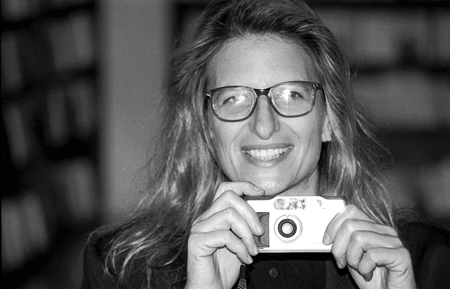Annie Leibovitz
Anna-Lou “Annie” Leibovitz (born October 2, 1949) is an American portrait photographer whose style is marked by a close  collaboration between the photographer and the subject. She is renowned for having taken photographs of some of the most famous people of this generation, including John Lennon and Bob Dylan.
collaboration between the photographer and the subject. She is renowned for having taken photographs of some of the most famous people of this generation, including John Lennon and Bob Dylan.
Education
Born in Conneticut, she attended the San Francisco Art Institute but enrolled to study painting. It was only until she visited Japan during her sophomore year that she realised that she was more interested in photography.
Rolling Stone
In 1970 Leibovitz approached Jann Wenner, founding editor of Rolling Stone, which he’d recently launched and was operating out of San Francisco. Impressed with her portfolio, Leibovitz her first assignment was to photograph John Lennon. Leibovitz’s black-and-white portrait of the shaggy-looking Beatle was the cover of the January 21, 1971 issue. Two years later she was named Rolling Stone chief photographer.
When the magazine began printing in color in 1974, Leibovitz had to teach herself about lighting and colour. During this period, she photographed Bob Dylan, Bob Marley, and Patti Smith. Leibovitz also served as the official photographer for the Rolling Stones’ 1975 world tour. While on the road with the band she produced her iconic black-and-white portraits of Keith Richards and Mick Jagger.
In 1980 Rolling Stone sent Leibovitz to photograph John Lennon and Yoko Ono, who had recently released their album “Double Fantasy.” A few hours later, Lennon was assassinated. Her photograph ran on the cover of the Rolling Stone Lennon commemorative issue. In 2005 the American Society of Magazine Editors named it the best magazine cover from the past 40 years.
Vanity Fair
In 1983, Leibovitz joined Vanity Fair and was made the magazine’s first contributing photographer. At Vanity Fair she became known for her provocative portraits of celebrities. Most famous among them are Demi Moore naked and holding her pregnant belly. She has photographed Whoopi Goldberg, Brad Pitt, Mikhail Baryshnikov, Ellen DeGeneres, the George W. Bush cabinet, Michael Moore, Madeleine Albright, Bill Clinton, Scarlett Johannson and Keira Knightley (the last two nude), Tom Ford in a suit; Nicole Kidman in ball gown and spotlights.
Her portraits have appeared in Vogue, The New York Times Magazine, and The New Yorker, and in ad campaigns for American Express, the Gap, and the Milk Board.
Private Life
Leibovitz met Susan Sontag in 1989 while photographing the writer for her book AIDS and its Metaphors. They remained together until the latter’s death in 2004. Sontag profoundly influenced Leibovitz, visible in the greater interest in political themes. In 1993 Leibovitz traveled to Sarajevo during the war in the Balkans. Among her work from that trip is Sarajevo, Fallen Bicycle of Teenage Boy Just Killed by a Sniper, a black-and-white photo of a bicycle collapsed on blood-smeared pavement. Sontag, who wrote the accompanying essay, also first conceived of Leibovitz’s book Women (1999). The book includes images of famous people along with those not well known. Celebrities like Susan Sarandon and Diane Sawyer share space with miners, soldiers in basic training, and Las Vegas showgirls in and out of costume.
References


